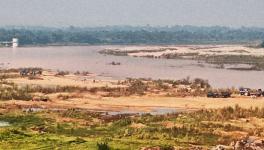India is Not Preparing for Climate Change
India ranks number five among countries most vulnerable to climate change, due to our tropical and subtropical climate and overwhelming dependence of most Indians on nature for their livelihood. India’s temperature is projected to rise by 1.7 to 2 degree Celsius by the end of 2030. This rise in temperature, it is projected, will lead to an eighteen-fold increase the population’s exposure to heat waves. Heat waves are an occupational health hazard, especially for manual labourers. Since the beginning of the last decade, they have increased at 200%. In just 2017, India lost 75 billion hours of labour solely due to heat waves. The ILO has said that by 2030, India could lose the productivity equivalent of 34 million jobs.
India is not alone. In the last decade extreme weather events arrived with much greater frequency and intensity. In 2018, in its Special Report 1.5, the IPCC or Intergovernmental Panel on Climate Change gave a clear warning that the world has just twelve years to limit global warming to 1.5 degree Celsius and avoid catastrophic impact of climate change. The irreversible changes in our natural systems increase the chances of extreme weather events and other climate hazards.
Climate change is already wreaking havoc in the agrarian sector in India and elsewhere. In 2019, about 45% of India faced drought and at least twelve states were devastatingly flooded. Farmers in the Indo-Gangetic plains will face severe stress due to rising temperatures. Rising temperatures can alter pest cycles and rainfall patterns, making farming in rain fed agriculture areas challenging.
Coastal areas are set to face more devastating cyclones, like those of 2019. As rising ocean temperatures melt glaciers and ice sheets, major economic cities such as Mumbai, Kolkata and Chennai will be severely affected by rising sea levels and salt water intrusion. This puts fisher-folk and the urban poor at serious risk. Mumbai in particular faces the twin threats of rain bombs and aerosol clouds.
The government and other projections have found that risks are likely to grow in coming years. Dealing with such a crisis requires strong adaptive and resilience measures. The Indian government has been trying to address the problem through the national and state Action Plans on climate change. These Action Plans aim to work through eight missions covering agriculture, habitats, energy efficiency, water, afforestation, Himalayan ecosystems, solar energy and strategic knowledge. The NAPCC dates back to 2008: despite missing targets, there has been no significant effort to revamp these missions. During a calling-attention motion on climate change in the Rajya Sabha, MP Jairam Ramesh said last year that the MoEFCC (ministry of environment) was sitting with the same document that was prepared a decade ago.
The state Action Plans are poorly drafted, lacking important details such as vulnerability assessments. Some experts refer to them as ‘copy-pasted’ documents. A report of the Centre for Science and Environment finds these missions lacking in all four essentials: cross-sectoral approach, funds and clarity on objectives and monitoring.
India’s preparedness can be judged from the fact that we do not even have micro-level data on climate projections or trends. We need to run climate models for different crops with soil, water and crop data down to district and block levels. Prof NH Ravindranath of the Indian Institute of Science, Bangalore, who leads the first national study on climate data, has said that for actual planning and adaptation and to really help communities, we need good climate change projections; but there is no plan to gather such data. Current efforts are only to get a broad national level trend.
We need to identify institutions, network them, provide required infrastructure and train staffs to produce local level vulnerability reports. D Raghunandan of the Delhi Science Forum has also said that most research institutions lack funding. In addition to climate data models, he emphasises the need to collect data and use it to plan and map risks such as sea-level rise. Given our economic dependence on coasts, this is extremely important.
India also does not study the impact of climate change on health, forests and infrastructure. Yet, climate change will affect everything—from railways and ports to dams and other infrastructure. Such data is the first step to cure our lack of even basic planning; such as for mass evacuation of the most vulnerable cities, which includes Mumbai.
The next challenge is to provide for an early warning system to inform the most vulnerable sections. Cyclone Phani inflicted fewer casualties due to an effective early-warning system and strong relief infrastructure. Considering the increased frequency, we need concrete mechanisms to help disaster victims recover and resettle. Livelihoods need to be made more resilient through invention of new methods, raw materials and building capacities among the local communities. Agriculture, too, especially needs a significant push. Research into new seeds and techniques are essential in light of extreme weather events and expected fall in yields. It is disheartening that Finance Minister Nirmala Sitharaman did not even mention in Union Budget 2020 the risks farmers fame from extreme weather events.
Even urban infrastructure needs significant restructuring to adapt to increased rains and heatwaves. There will be 200 million new city-dwellers by 2030, all requiring housing, transport etc. This massive challenge will be aggravated by loss of livelihood as the economy attempts a green transition. The Finance Minister did mention that old and higher-emission thermal power plants will be shut, but there is no discussion on the expected job losses such measures will cause. Although India mentioned ‘green jobs’ in its last Biennial Update Report to the IPCC, it did not support the Just Transition Declaration at COP-24, which calls for planning to provide such green jobs.
India is in the middle of an ecological crisis while it strives to fulfil development needs to cater to basic needs. Development plans are meaningless today unless they are climate-proof. It is the task of planners to incorporate the challenges of climate change into the road ahead while exploiting the co-benefits of the changed scenario, such as stepping into the waste-to-resource economy, which can produce three million jobs directly and 15 million indirectly.
The author is teaching associate in environmental law at NLSIU. The views are personal.
Get the latest reports & analysis with people's perspective on Protests, movements & deep analytical videos, discussions of the current affairs in your Telegram app. Subscribe to NewsClick's Telegram channel & get Real-Time updates on stories, as they get published on our website.























